Elderberry jelly is a delicious way to preserve elderberries, and it’s perfect on your morning toast (or in elderberry thumbprint cookies).
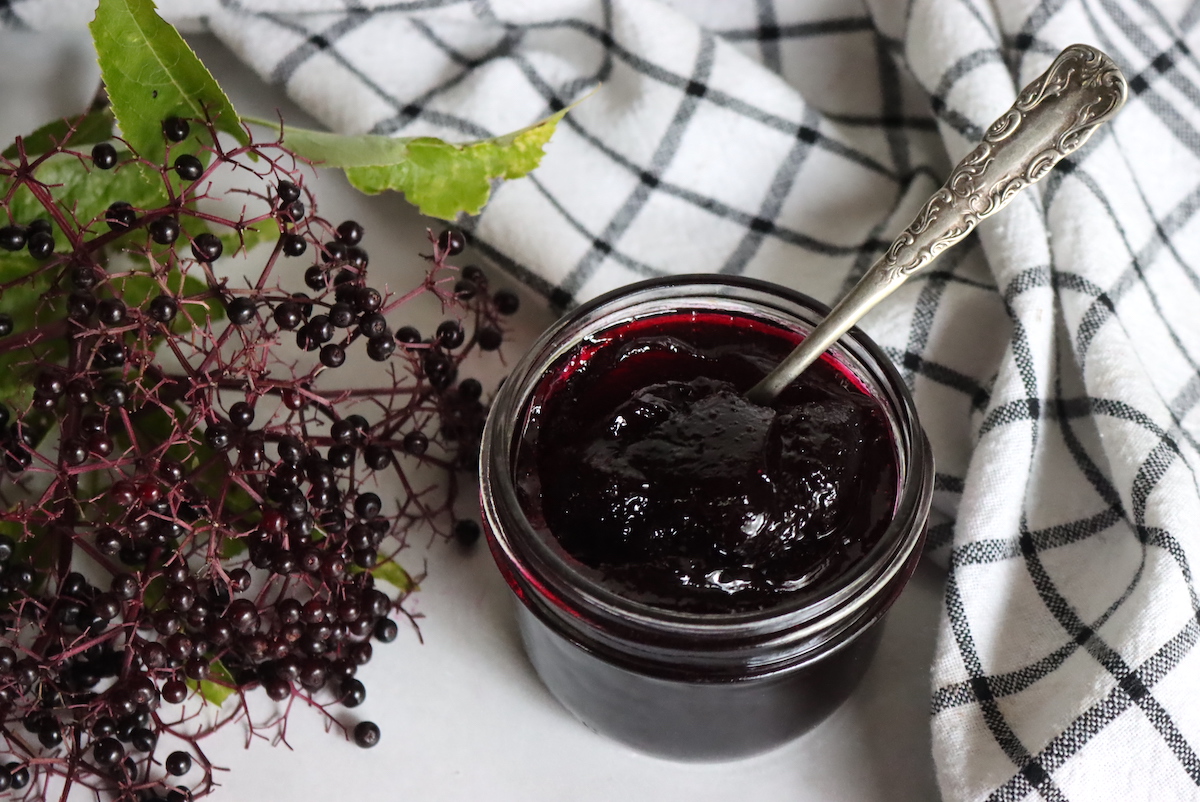
Elderberry syrup gets all the attention, but believe it or not, elderberry jelly is just as medicinal and it’s a lot easier to use. Rather than taking immune boosting elderberry syrup on a spoon, you can slather elderberry jelly on your morning toast and make your food your medicine.
Elderberries are not only medicinal, they’re delicious, and they make a wonderful jelly just for the flavor. Their immune boosting properties are just a bonus.
We grow a lot of different fruits on our homestead, and elderberries are one of my favorites, specifically because they make such a wonderful homemade elderberry jelly!
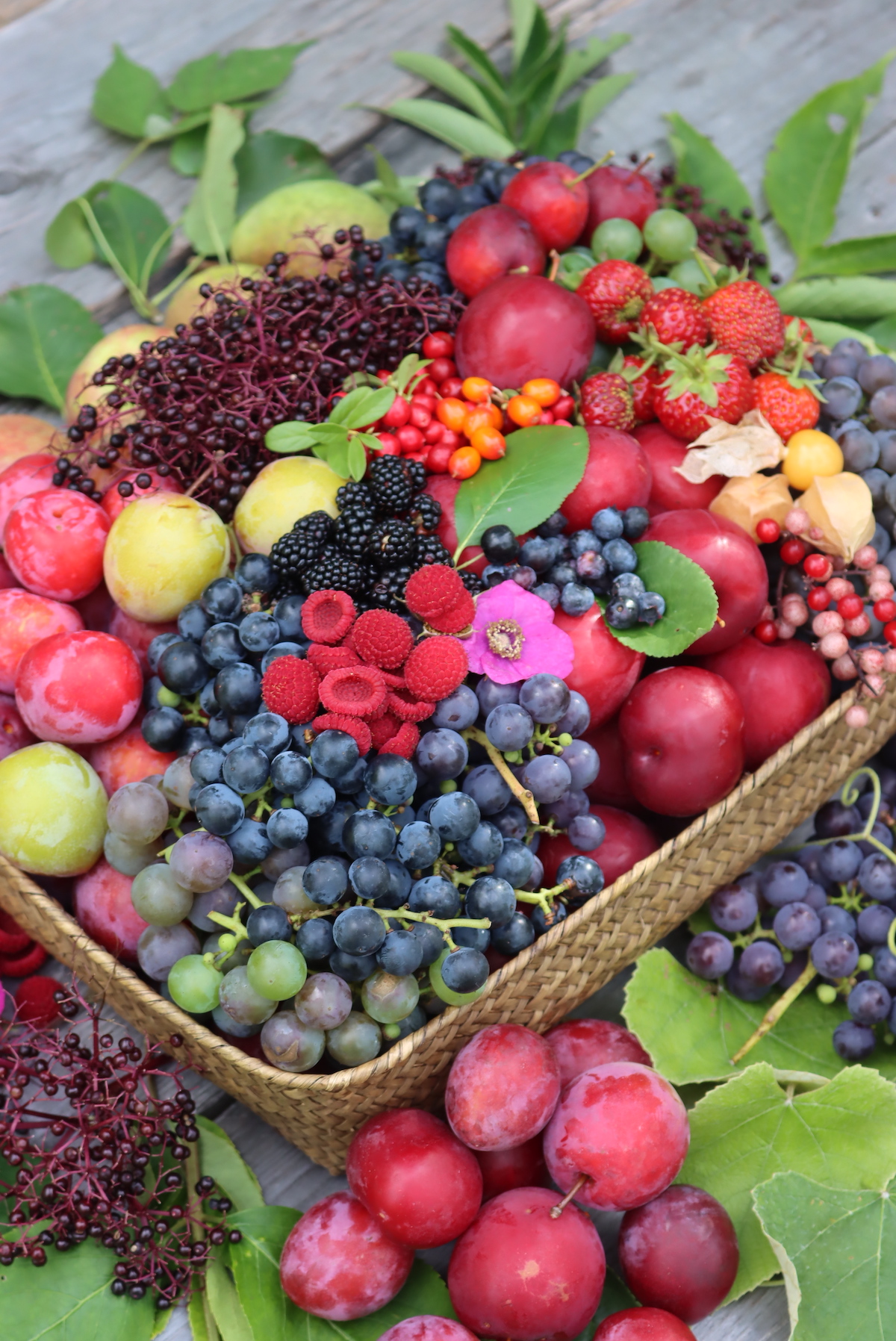
An array of fruits that we grow on our homestead. This is our September harvest basket, as elderberries ripen late her in the North. They’re available in July and August in many other locations.
Are Elderberries Safe for canning?
Elderberries have gained a lot of popularity lately for their medicinal properties, but they can be hard to preserve. Elderberry syrup, believe it or not, is not approved for canning as elderberries aren’t all that acidic. Fruits need to be below a pH of 4.6 for safe canning, and most elderberries are right around a pH of 5.
The National Center for Food Preservation has come up with a few safe, tested elderberry canning recipes, but only for elderberry jelly and elderberry jam.
Many tested canning recipes for borderline fruits that aren’t acidic enough for canning have you add bottled lemon juice to bring the pH into an acceptable range, but this time the recipe was created a bit differently. Instead of adding acidity, the National Center for Food Preservation opted to test a high sugar recipe instead.
With enough sugar added, fruits that aren’t acidic enough for canning can be safely canned because pathogens can’t exist in very high sugar environments. While the proper amount of lemon juice hasn’t been tested, the proper amount of sugar has been tested to ensure canning safety.
Sadly, this means you can’t create a low sugar elderberry jelly. I do love low sugar jellies, but elderberries actually work out really well as a high sugar jelly, and it’s delicious just the same.
Here are the specific requirements for safely canning elderberry jelly, straight from the Wisconsin State Extension:
- For Jelly, the weight ratio of elderberry juice to sugar must be no more than: weight of fruit juice/ weight of sugar = 45/55 = 0.82. For every 16 ounces (1 pound) of fruit juice for Jelly, your recipe must include at least 19.5 ounces, by weight, of sugar. A lower ratio is acceptable; this means that you are adding more than the minimum amount of sugar and that is great for safety.
- Lemon juice added in some jam and jelly recipes is to help pectin form a gel; it can not be relied on to provide a pH low enough to prevent botulism but is essential for a quality product. Besides fruit/juice and sugar, add lemon juice and pectin if you are making elderberry jam or jelly.
- Do not use honey as a sugar source.
- Do not use low-sugar or no-sugar added pectin or vary these weight proportions of fruit/juice to sugar, an unsafe product may result.
Weighing fruit juice can be a bit tricky, especially in US kitchens where food scales aren’t the norm. I’ve converted this to a standard jelly recipe for convenience.
You’ll need 4 1/2 cups sugar for every 3 cups of elderberry juice. That quantity of elderberry juice is made from 3 lbs stemmed elderberries cooked with 1/2 cup of water then strained through a jelly bag.
That’ll give you the right amount for a single box of standard pectin (1.75 oz) and yield 5 to 6 half pint jelly jars.
I also add 1/4 cup of lemon juice, which improves the flavor of the finished jelly, adding a bit of tart to balance the sugar. The lemon juice is optional, but recommended. Keep in mind, the sugar cannot be reduced if canning.
Ingredients for Elderberry Jelly
To make 5 to 6 half pint jelly jars, you’ll need the following:
- 3 cups elderberry juice (from 3 lbs stemmed elderberries cooked with 1/2 cup water)
- 4 Tbsp lemon juice (or more, for a more tart jelly)
- 4 1/2 cups sugar (I know, it’s a lot, but required for canning safety here, and elderberries aren’t sweet naturally)
- 1 box (1.75 oz) pectin (I’m using Sure-Jell)
For safe canning, the sugar and juice proportions must be followed as listed above. You can add more sugar if you’d like, but not less.
If you’re making a refrigerator or freezer jelly, then you can use less sugar and a low sugar pectin. Instructions for low sugar pectin vary by brand, but I’d recommend following the box’s instructions for berry jelly (blueberry, etc). If using Sure Jel Low Sugar, the instructions are the same as this recipe, you just reduce the sugar amount to as little as 1/4 cup.
Again, this is only if you’re making a refrigerator jelly, and you cannot water bath can low sugar elderberry jelly. Do not lower the sugar in this recipe if canning.
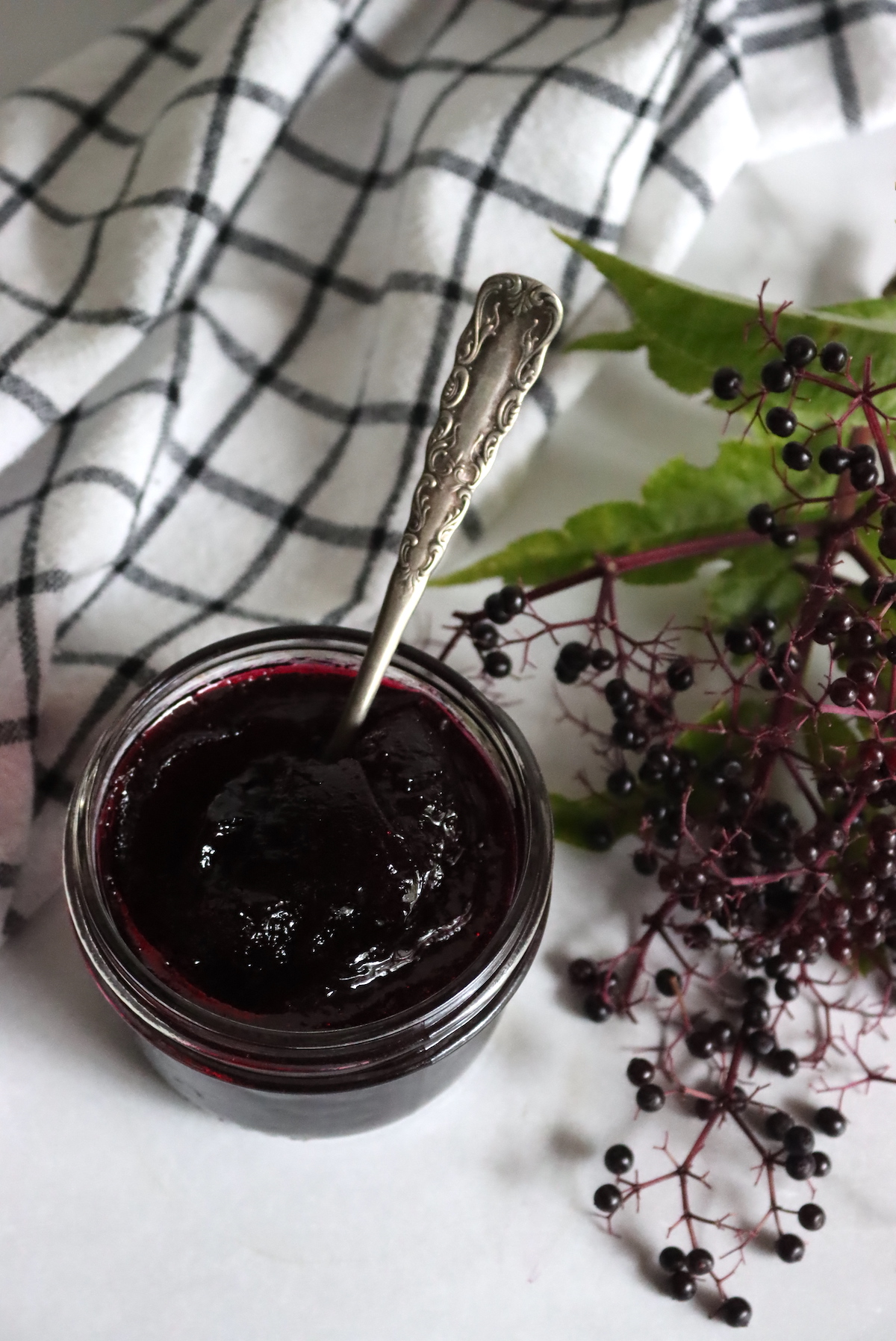
How to Make Elderberry Jelly
Making elderberry jelly starts with stemming the elderberries. Do not cook the elderberries on the stem because the stems will give a bitter flavor to the jelly, and elderberry stems and leaves are mildly toxic.
Since elderberries are a soft fruit, stemming them can be messy when they’re fresh. It’s actually a lot easier to stem frozen elderberries.
Freeze whole sprays of fresh elderberries until fully frozen, at least 4 hours, preferably a bit longer.
Once frozen, use your hands or a fork to gently strip the elderberries from their stems. When frozen, they should pop off easily with minimal mess.
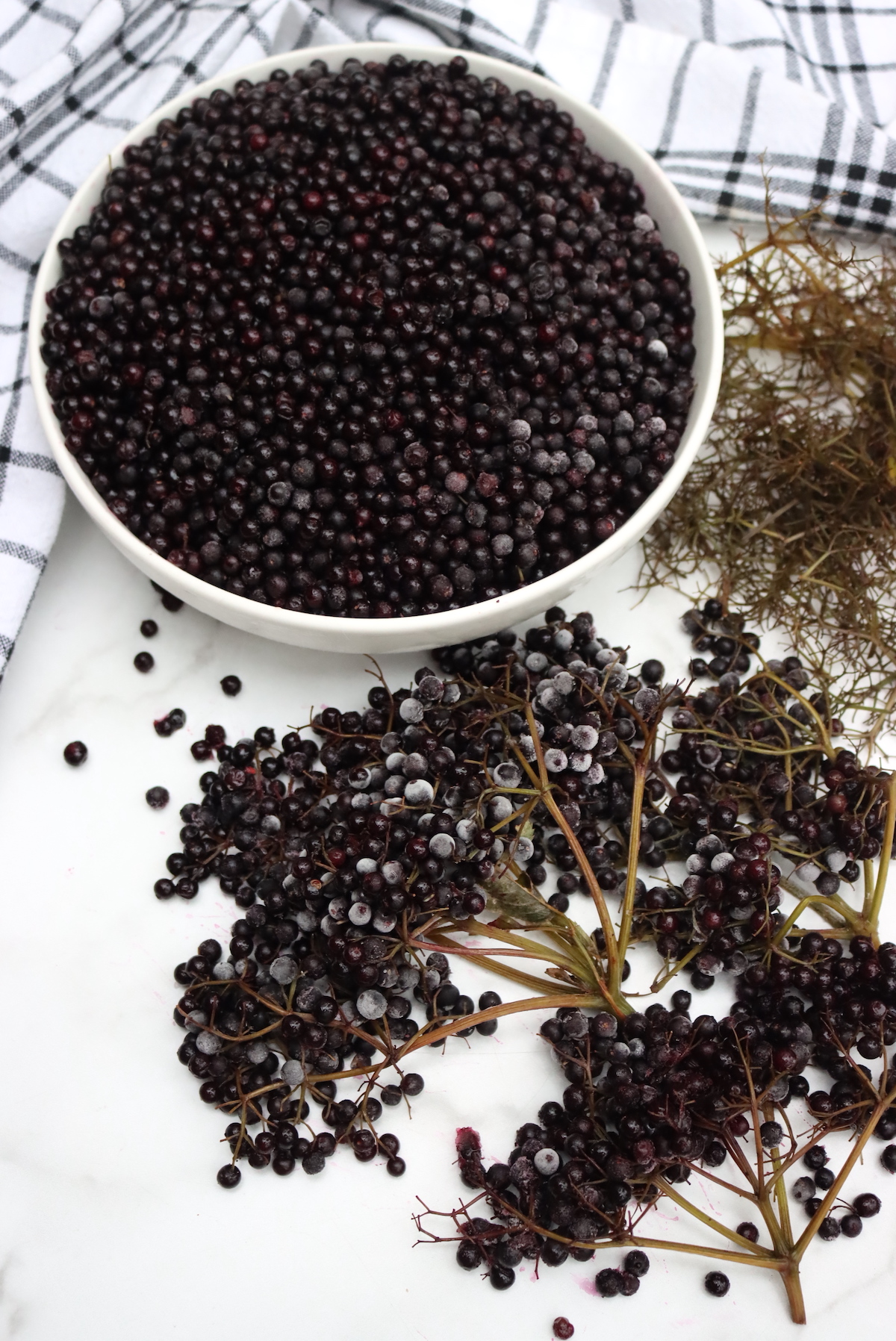
Once the elderberries are stemmed, the process is relatively straightforward and the same for making just about any jelly with pectin. Place the elderberries in a saucepan with about 1/2 cup of water and bring them to a boil, stirring frequently.
Cook the berries for about 5 minutes, until they’ve completely fallen apart and released their juices. Mashing with the back of a spoon or a potato masher helps with this process.
Strain the juice through a jelly bag and measure the juice. If you started with 3 lbs stemmed elderberries (about 11 to 12 cups) and 1/2 cup water, you should have about 3 cups juice.
If you have less juice, add a bit of water or apple juice to bring the volume up to 3 cups. If you have more than 3 cups, save the rest for a different recipe (or make a 2nd batch later). Do not double or increase the batch size of this recipe to make it all at once.
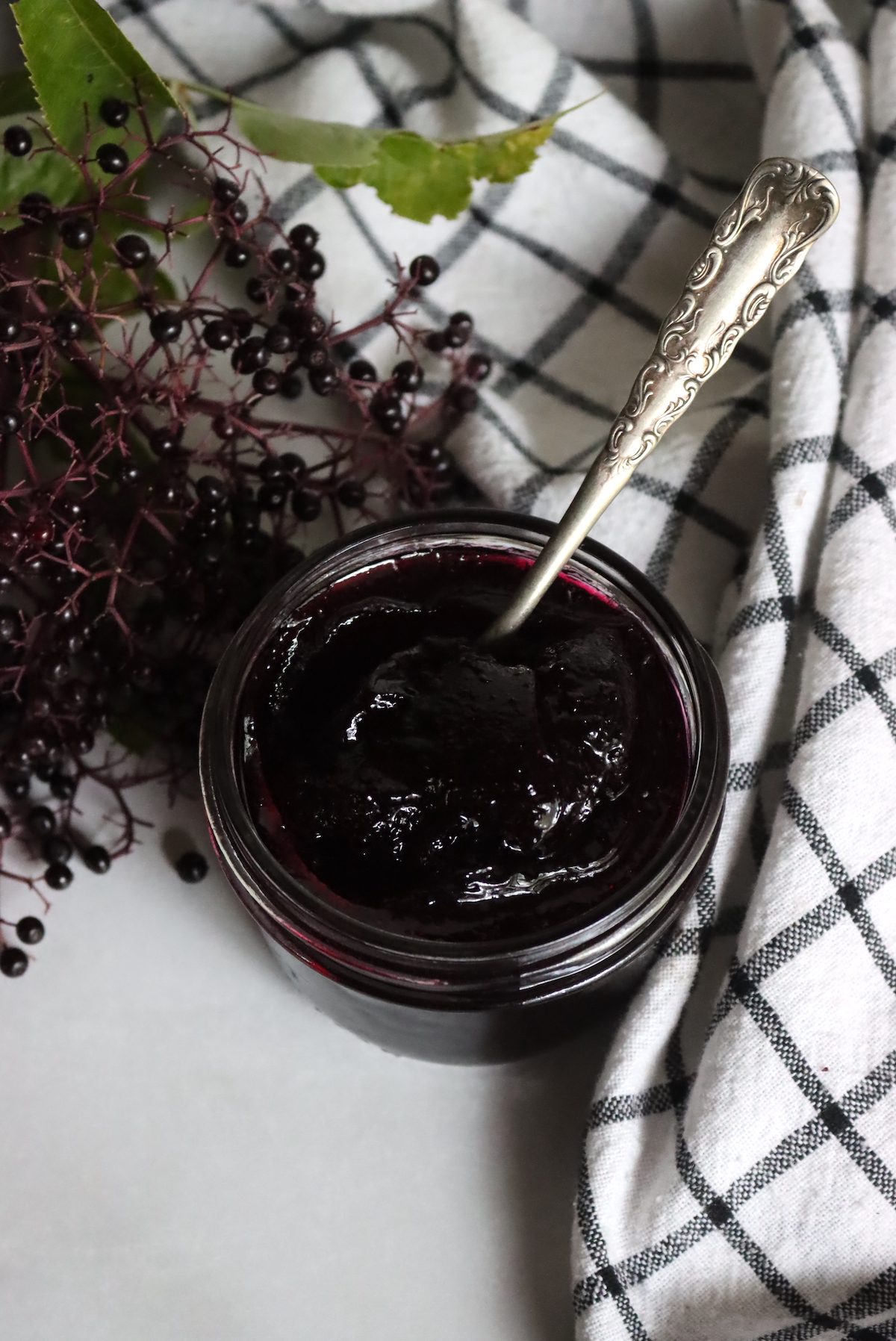
Prepare a water bath canner and jars at this point, if canning.
To make elderberry jelly, add the measured juice to a jelly pot, along with the box of pectin and lemon juice. Don’t add the sugar yet. (Adding the sugar early can prevent the jelly from setting.)
Stir to dissolve the pectin and turn on the heat to medium high. Bring the mixture to a boil and boil for 1 minute.
Add the sugar, stirring to dissolve, and return the mixture to a boil for 1 minute.
Remove the mixture from the heat and ladle into prepared jelly jars, leaving 1/4 inch headspace. Cap with 2 part canning lids and process in a water bath canner for 10 minutes (or 15 minutes if above 6,000 feet in elevation).
Can you Make Elderberry Jelly with Dried Elderberries?
Yes, you can make elderberry jelly with dehydrated elderberries. Start with 5 cups of elderberries. Cover them with about 5 cups of boiling water and allow them to sit for at least an hour, but preferably overnight.
Pour the mixture into a saucepan and bring the mixture to a boil, gently mashing the fruit to get them to release more juice. Strain through a jelly bag and proceed with the recipe as written. You should have a bit more than the required 3 cups of juice. Save the rest for another use (it makes a lovely elderberry tea to drink as is).
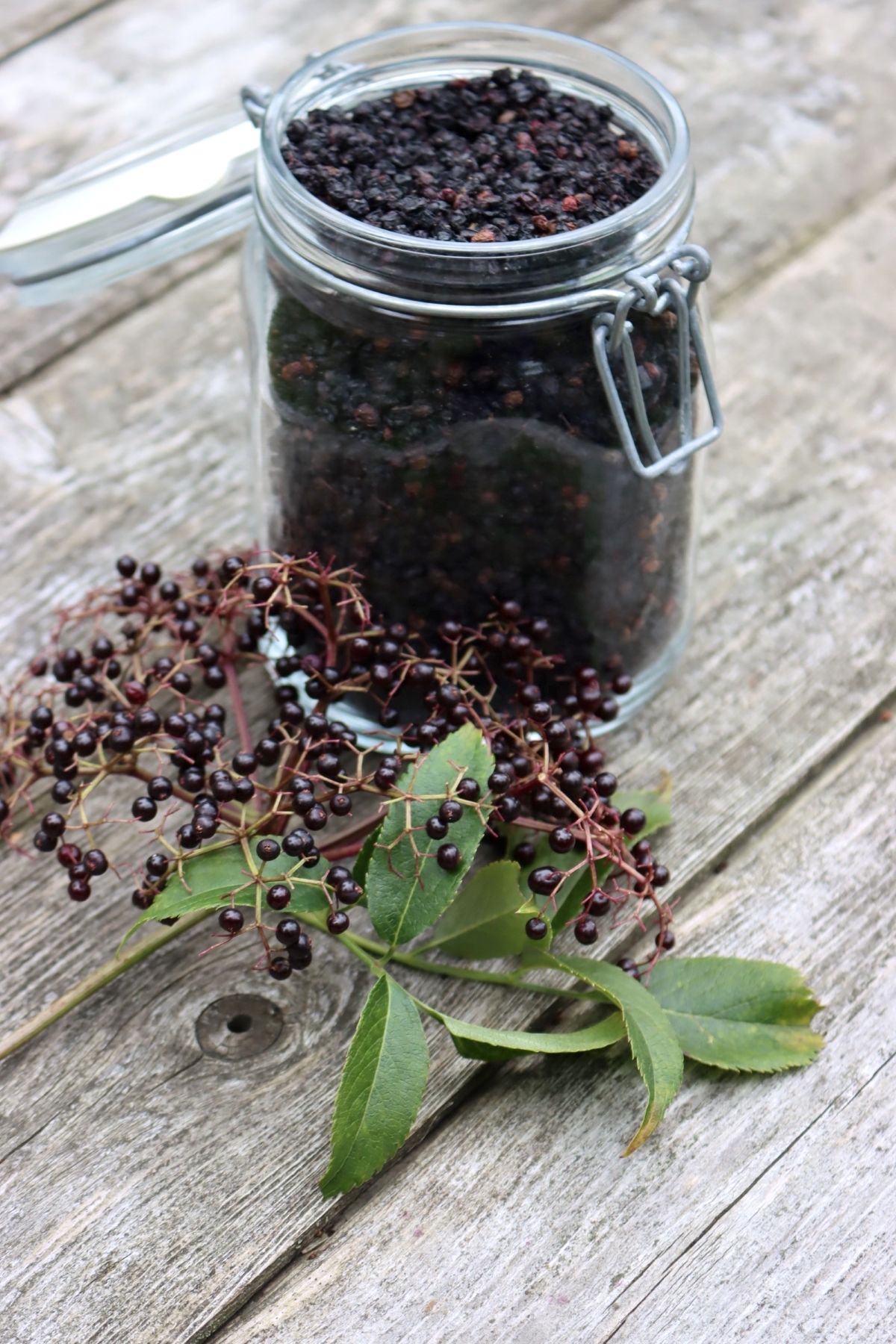
Canning Elderberry Jelly
Reminder, you cannot reduce the sugar in this recipe if canning.
If canning, make the recipe as described, preparing a water bath canner before beginning.
After the jelly has been boiled with the sugar for 1 minute, remove from the heat and ladle into prepared jelly jars, leaving 1/4 inch headspace. Cap with 2 part canning lids and process in a water bath canner for 10 minutes (or 15 minutes if above 6,000 feet in elevation).
Once the canning time is complete, turn off the heat and allow the jars to sit in the canner for an additional 5 minutes (this helps prevent siphoning). Use a jar lifter to remove the jars to cool completely on a towel on the counter.
After 24 hours, check steals and store any unsealed jars in the refrigerator for immediate use within the next week or two.
Properly canned and sealed jars of elderberry jelly will maintain peak quality on the pantry shelf for 12 to 18 months, and be safe to eat as long as the jars are sealed. Refrigerate after opening.
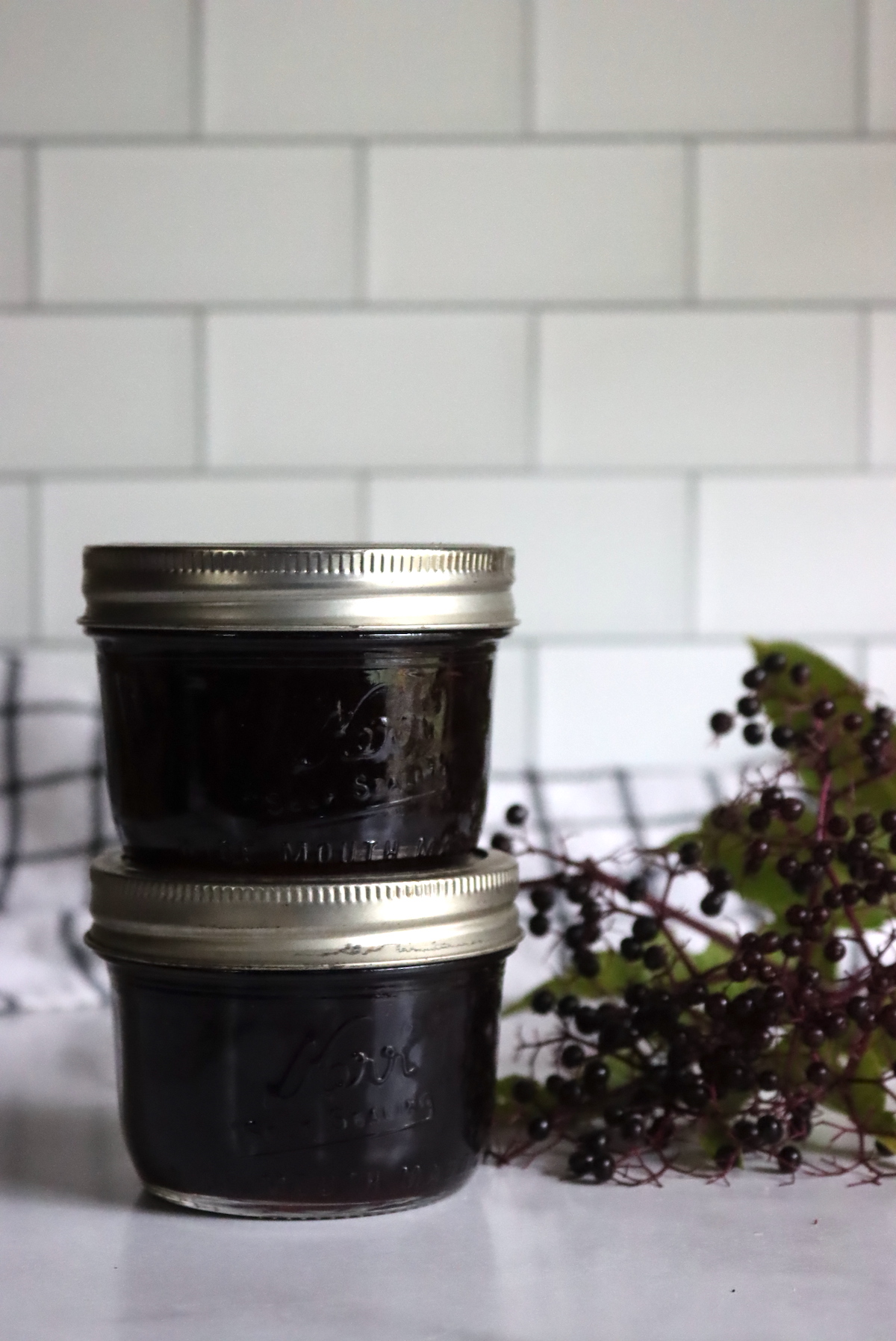
Ways to Preserve Elderberries
Looking for more ways to preserve elderberries?
- Elderberry Syrup
- Elderberry Wine and Mead
- Elderberry Tincture
- Elderberry Oxymel
- Drying & Freezing Elderberries
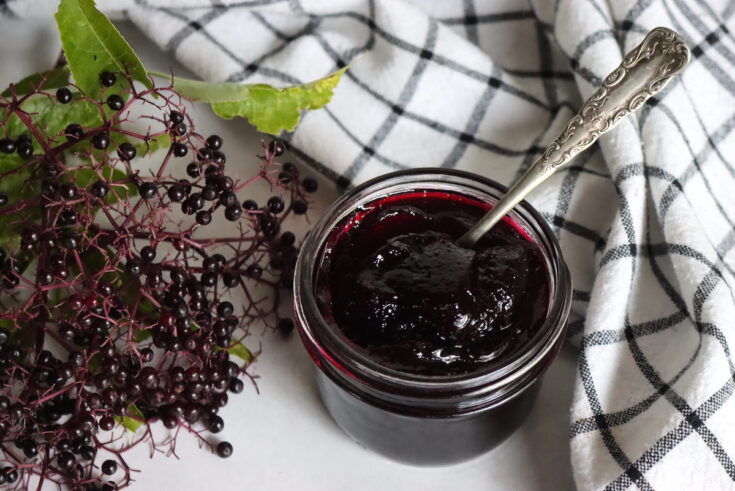
Elderberry Jelly
Elderberry jelly is an easy way to preserve elderberries for the winter, and it's even more useful and versatile than elderberry syrup!
Ingredients
- 3 cups elderberry juice (from 3 lbs stemmed elderberries cooked with 1/2 cup water)
- 1/4 cup lemon juice
- 4 1/2 cups sugar (I know, it's a lot, but required for canning safety here, and elderberries aren't sweet naturally)
- 1 box (1.75 oz) pectin (I'm using Sure-Jell)
Instructions
Making Elderberry Juice for Jelly
- Start by stemming the elderberries. They're easiest to stem if you freeze the whole sprays of fruit for at few hours (or overnight) first. Frozen fruit pop off the stems easily, and the freezing process helps them release their juice for jelly.
- Once the elderberries are stemmed, place them in a saucepan with 1/2 cup of water. You'll need 11-12 cups of stemmed elderberries, or about 3 pounds of fruit, to get a yield of 3 cups of elderberry juice for this recipe.
- Bring the elderberries and water to a simmer and cook them for about 5 to 6 minutes, gently mashing them with the back of a spoon to help them release their juices. Once the fruit have fallen apart, remove the pan from the heat and strain the mixture through a jelly bag (or a mesh strainer lined with 2 layers of damp cheesecloth).
- Measure the resulting juice, you should have about 3 cups. If you have more than 3 cups, save the extra for another recipe. If you have less, add water or apple juice to bring the total up to 3 cups.
Making Elderberry Jelly
- If canning, prepare a water bath canner, jars and lids before beginning.
- To make elderberry jelly, place 3 cups of elderberry juice into a pot and add the lemon juice and powdered pectin. Do not add sugar yet. Adding the sugar early will prevent your jelly from setting.
- Stir the pectin to break up any clumps and ensure it's fully dissolved.
- Turn on the heat and bring the mixture up to a boil. Boil hard for 1 minute.
- After the pectin/juice mixture has boiled for 1 minute, add the sugar.
- Return the mixture to a boil and boil for 1 minute.
- Remove from the heat and ladle into prepared jars, leaving 1/4 inch headspace. Seal with 2 part canning lids.
- If canning, process the jars in a water bath canner for 10 minutes (or 15 minutes if above 6,000 feet in elevation). Once the processing time is complete, turn off the heat and allow the jars to sit in the canner for an additional 5 minutes before removing them with a jar lifter to cool on a towel on the counter (this helps prevent siphoning).
- Allow to cool completely and check seals after 12 hours. Store any unsealed jars in the refrigerator for immediate use. Properly canned and sealed jars will maintain peak quality on the pantry shelf for 12-18 months, and be safe to eat as long as they're sealed. Refrigerate after opening.
Easy Jelly Recipes
Filling jelly jars with more than just homemade elderberry jelly?
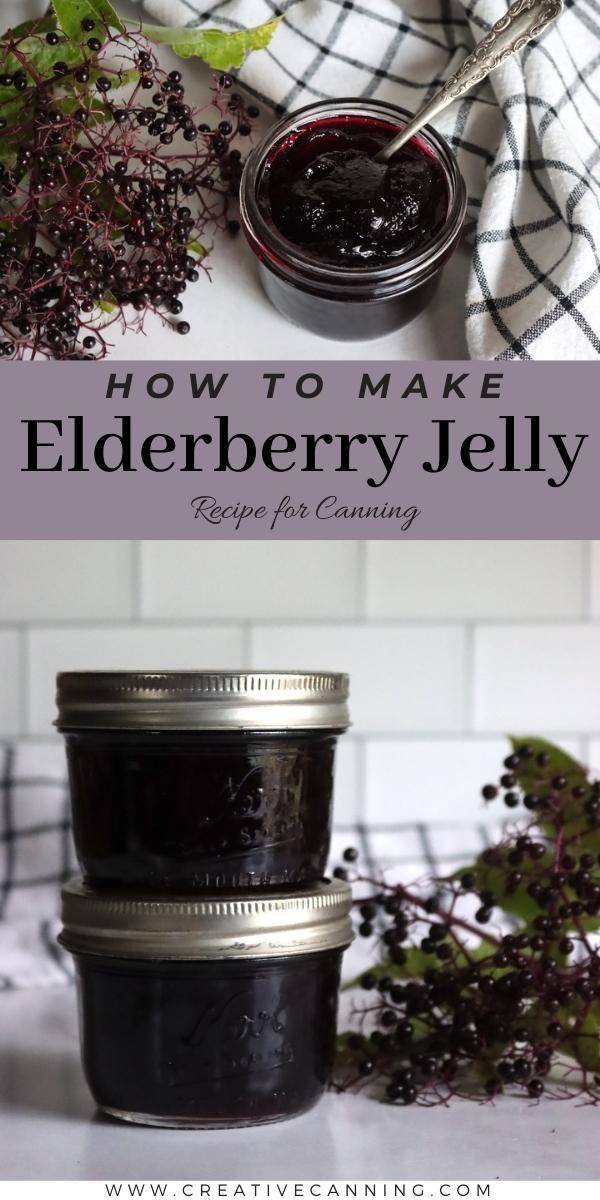
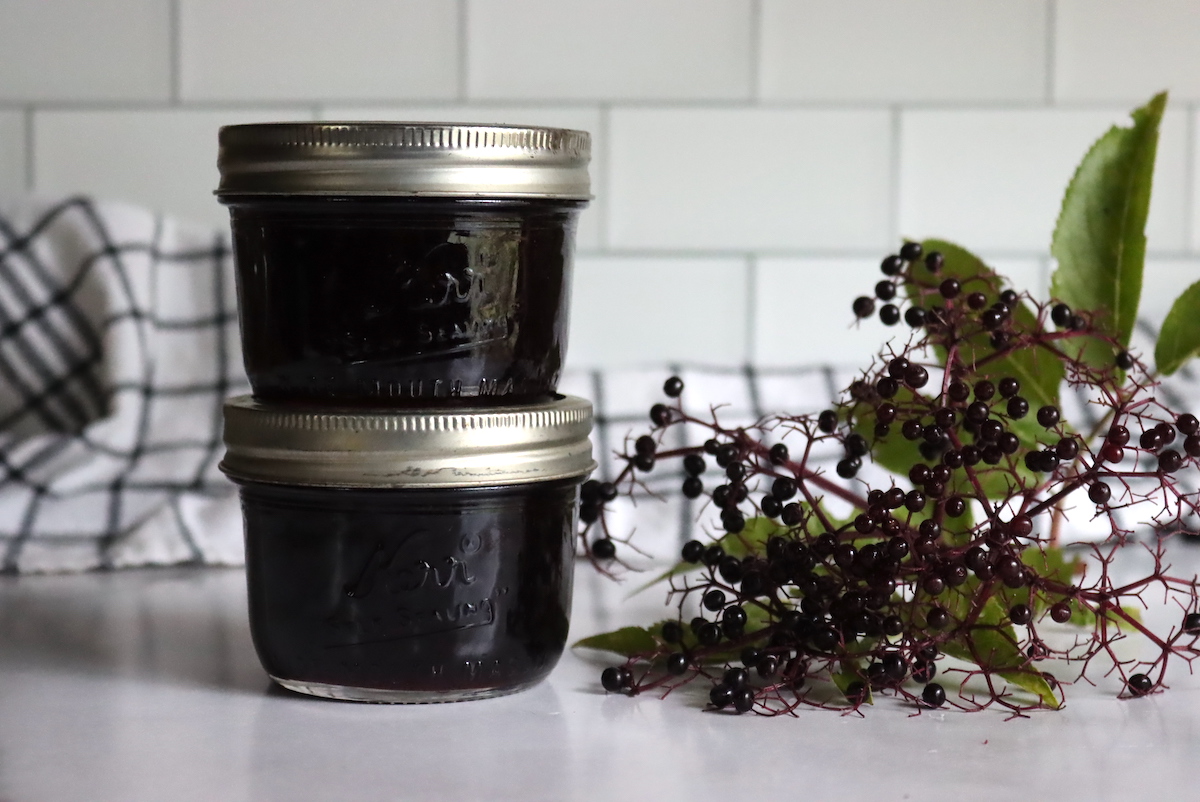
Zarah
Can I please ask your opinion on why honey is not a suitable replacement for sugar? Sugar is super unhealthy and causes a range of serious health issues and honey is a natural preservative.
Ashley Adamant
Honey in general can be used in place of sugar in almost every canning recipe…but not this one. The reason is that elderberries are not acidic, so the preservative here is the sugar. Honey has different preservative properties, of course, but there’s a certain minimum amount of sugar you need to inhibit bacterial growth in something that’s above a pH of 4.6. If you used honey, you’d need even more of it by volume than the sugar, and the exact amount hasn’t been tested. It’s perfectly fine to use honey if you’re not canning, and just keep it as a refrigerator or freezer preserve.
In every other jam canning recipe on my site, and really ever other one I’ve seen from the USDA, you can cut the sugar, eliminate the sugar or replace it with honey, no problem. This recipe is one big exception as these particular fruits are not acidic enough on their own.
Gabriele
I followed the link to the Wisconsin extension office, but I can not find anything from them about elderberry jelly, no matter how I search it.
Ashley Adamant
That’s frustrating! It looks like they’ve completely re-done their website and most of the canning content is gone. Well, I put the URL into the internet archive and here’s what the page had when I cited it: https://web.archive.org/web/20221006000403/https://fyi.extension.wisc.edu/safefood/2020/06/05/elderberries-beautiful-to-look-at-not-for-canning/